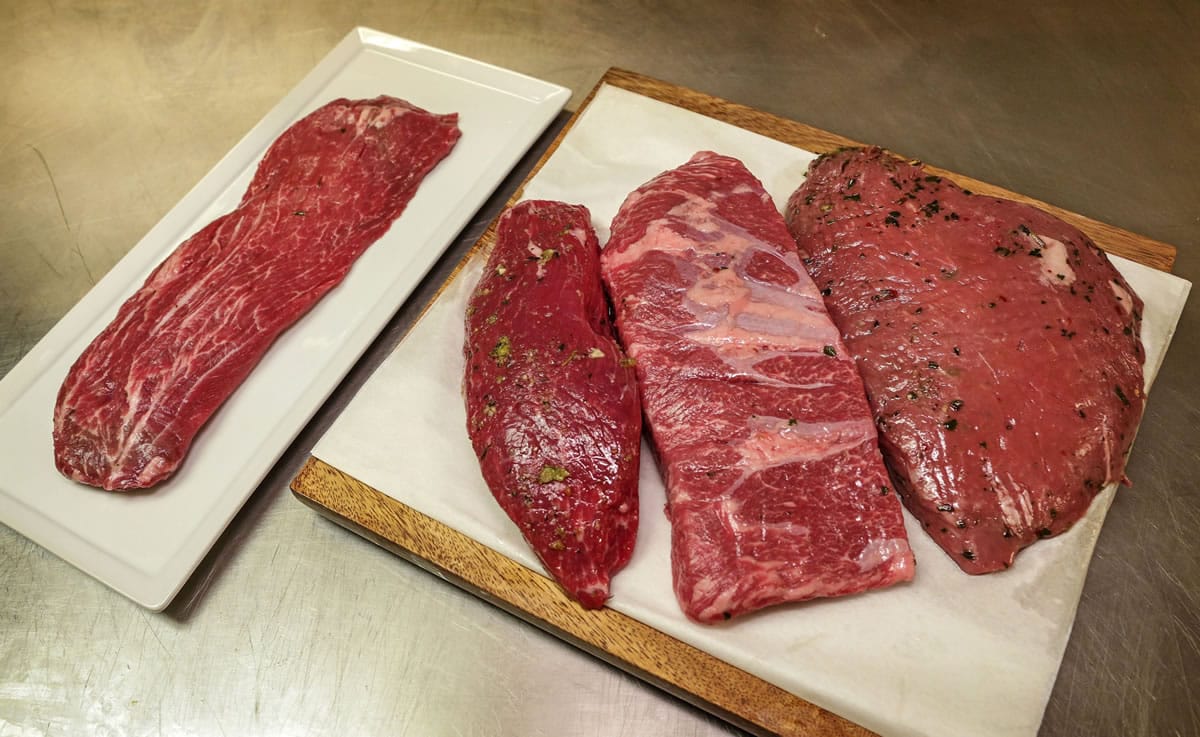For generations, beef shoulder was a blue-collar cut of cow, fit for the meat grinder or crockpot but not much else.
But where others saw pot roast, Tony Mata saw potential.
Mata is a Dallas meat scientist whose mission is to find hidden gems in rough parts of the steer. He and a team of researchers came up with the industry’s newest steak by mining the muscle under the shoulder blade for a tender pad of flesh.
Unveiled last year at a trade show, the meat is starting to land on restaurant menus. At about $6 a pound, it sells for twice the price of hamburger and has a catchy name to boot: the Vegas Strip Steak.
“People think I’m crazy trying to look for new steaks in an animal we’ve domesticated for thousands of years,” Mata said. “But as an industry, we’ve ignored all these other muscles. I truly believe there’s still two or three more steaks out there.”
Mata’s persistence is a testament to changing fortunes in the beef industry. U.S. per capita beef consumption has been falling for decades as consumers have shifted to lighter fare. Pricey prime rib and filet mignon have vanished from many American tables in a sluggish economy.
That has the beef industry scouring the animal for affordable delicacies — cuts that will fetch higher prices than burger without breaking the bank for shoppers. Now steaks with names such as ranch, petite tender, Denver and Sierra are popping up in meat cases alongside familiar names such as sirloin and porterhouse.
“Any time you can make something steak-able, you’re bringing more dollars back to the carcass,” said Jake Nelson, a meat processing specialist at Oklahoma State University who worked with Mata on the Vegas Strip Steak.
Such efforts began in earnest more than a decade ago. That’s when the U.S. industry’s promotional arm, known as the Beef Checkoff, funded research to find cuts tasty and tender enough to turn into inexpensive steaks.
Researchers at the University of Nebraska and the University of Florida studied more than three dozen muscles, focusing mainly on the shoulder or chuck, as well as the round, which is the back leg. They measured tenderness, trimmed the gristle and spent hours in test kitchens cooking up the results.
Top-quality steaks have traditionally come from the steer’s midsection, which is supple and easy to butcher. Chris Calkins, a University of Nebraska professor who worked on the project, said skepticism abounded among meatpackers that anything valuable would be found in the animal’s ropy front and behind.
But in a portion of the chuck known, unappetizingly, as the shoulder clod, they found a large pocket of marbled meat. All it required was some nimble knife skills, and suddenly there were the makings of an elegant steak. They dubbed it the flatiron because it resembled an antique steel clothing iron.
Retailing for about $6 a pound, the flatiron is now America’s sixth most popular steak, overtaking the porterhouse last year.
And it has changed the economics of beef. Experts estimate that it has helped add $50 to $70 to the value of the average steer — impressive, considering that an entire animal goes for about $1,600.
The flatiron has enabled restaurants to serve a hearty steak at relatively affordable prices. The Tender Greens restaurant chain offers a sliced flatiron plate with side dishes for $11.
Although the flatiron is the runaway sales leader among the newer cuts, nothing can beat the recently introduced country-style ribs for sheer imagination. These “ribs” are boneless — and they aren’t found near the animal’s rib cage. Instead, this meat is sliced from the chuck.
Erik Oberholtzer, co-founder of Tender Greens, said he slow-cooks these faux ribs for hours over hickory wood, then tops them with a homemade chipotle barbecue sauce.
“They come out soft, juicy and fall apart without the mess of bones,” he said.
Other industry innovations amount to little more than smaller portions. Take the New York strip fillet. It’s essentially a typical 1-pound New York strip steak split in half. That might seem like cheating, but beef marketers defend it as good value for consumers on a budget.
“They’re still enjoying a high-quality steak but at a lower cost,” said Trevor Amen of the National Cattlemen’s Beef Association.
Economic conditions have long spurred reinvention when it comes to America’s favorite red meat.
The Great Depression gave rise to the lowly cube steak, a slice of top round or top sirloin so tough that it needs to be pulverized with a mallet to make the meat fit to chew.
Still, getting consumers to embrace new cuts like the petite tender has been anything but a slam-dunk.
“I’ve never heard of them,” Justin Nathaniel, 25, who was grocery shopping recently at a Hollywood Vons, said about the new cuts. “I prefer the porterhouse. I want lots of marbling.”



